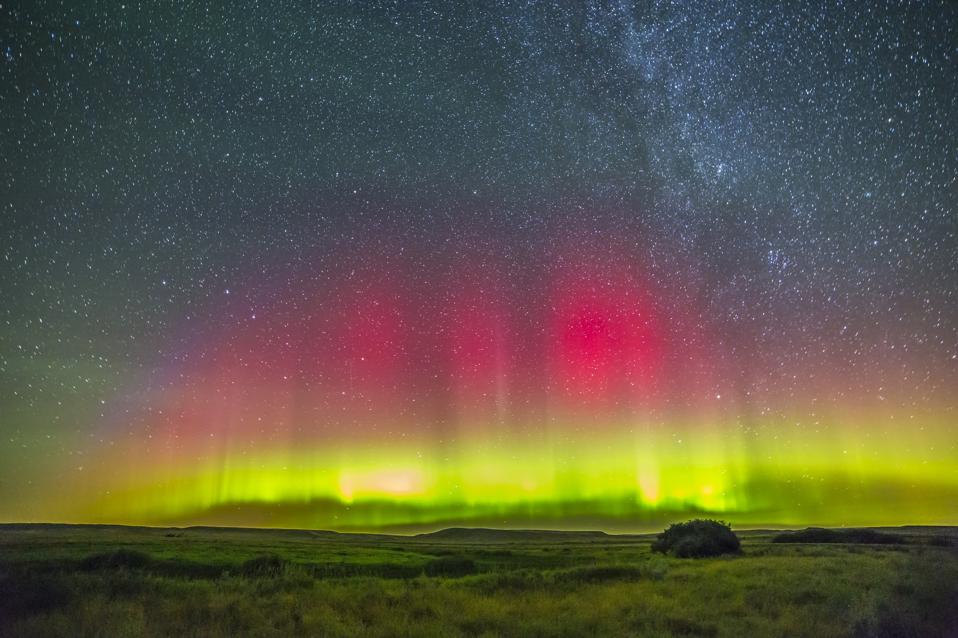The Northern Lights may be visible in the U.S. on Wednesday, April 16, with the possible arrival at Earth or a coronal mass ejection. According to the National Oceanic and Atmospheric Administration’s Space Weather Prediction Center, a geomagnetic storm could see aurora in Canada and as many as 18 U.S. states, with Alaska and those on the U.S.-Canada border having the highest chance.
It comes in the wake of Earth’s magnetic field being struck by a CME on Tuesday and as a meteor shower gets underway this week.
Where And When To See Aurora In The U.S. Tonight
As a result of a CME — a cloud of supercharged particles from the sun —arriving at Earth, a geomagnetic storm rated between G1 and G3 could result, according to NOAA. A G3 geomagnetic storm is classified as “strong” and can lead to auroras appearing at lower latitudes, potentially as far south as 45 degrees. That would mean auroras in Canada and northern-tier U.S. States.
“The aurora may become visible over many of the northern states and some of the lower Midwest to Oregon,” said a statement from NOAA. “The general public should consider monitoring our webpage for the latest information and updates.” It’s advised to see NOAA’s 30-minute forecast for the latest predictions — which are only accurate around 30 minutes beforehand or use the Glendale App for alerts.
The U.S. States That Could See Aurora Tonight
The U.S. states that could see the northern lights on Wednesday are Alaska, Washington, northern Oregon, northern Idaho, Montana, Wyoming, North Dakota, South Dakota, Minnesota, northern Iowa, Wisconsin, northern Illinois, Michigan, New York, Vermont, New Hampshire and Maine. Areas far from light pollution are likely to get the best views, with more northerly states having a much better chance of witnessing a display.
While a G3 geomagnetic storm was issued for Wednesday — due to the arrival of multiple coronal mass ejections that left the sun on April 13 — G1 geomagnetic storming conditions are likely to persist into Thursday, according to NOAA. A G1 geomagnetic storm is rated as minor in intensity and doesn’t typically cause aurora in the U.S. The geomagnetic storm on May 10, 2024 — the most powerful since 2003 — saw aurora as far south as Florida. It was rated as a G5 geomagnetic storm.
The Kp index — which provides a rough guide to the intensity of aurora displays — may reach 6, which will see the auroral oval stretch farther south. According to NOAA, for a Kp in the range of 6 to 7, the aurora can be “bright and active,” and it may be “possible to see the aurora from the northern edge of the United States.”
How To Photograph The Northern Lights Using A Smartphone
If your smartphone has a “Night Mode” feature, that should be good enough to get a more than impressive souvenir shot of the aurora. It likely means a long exposure of between five and 10 seconds, which will look much better if you do three things:
- Use your primary lens, NOT the super-wide lens (which is inferior).
- Use a basic smartphone holder and a small tripod to prevent any camera shake, keeping your images sharp. Failing that, support your phone on something solid, such as a gatepost or vehicle.
- Shoot in raw if you have the option, which will make it easier to improve your photos using simple edits.
What Causes The Northern Lights
The Northern Lights sometimes occur when charged particles from the sun — carried on the solar wind — interact with Earth’s magnetic field, creating luminous displays in the upper atmosphere as particles get excited. Last weekend, the sun was particularly restless, unleashing eight M-class solar flares between Friday and Monday. While solar flares themselves don’t directly cause auroras, they often set the stage for them by stirring up solar storms. Unusually, these solar flares didn’t come from sunspots — dark patches on the sun’s surface indicating intense magnetic activity— but magnetic filaments detaching from the sun. However, they still resulted in the two CMEs responsible for this week’s aurora displays.
Wishing you clear skies and wide eyes.

